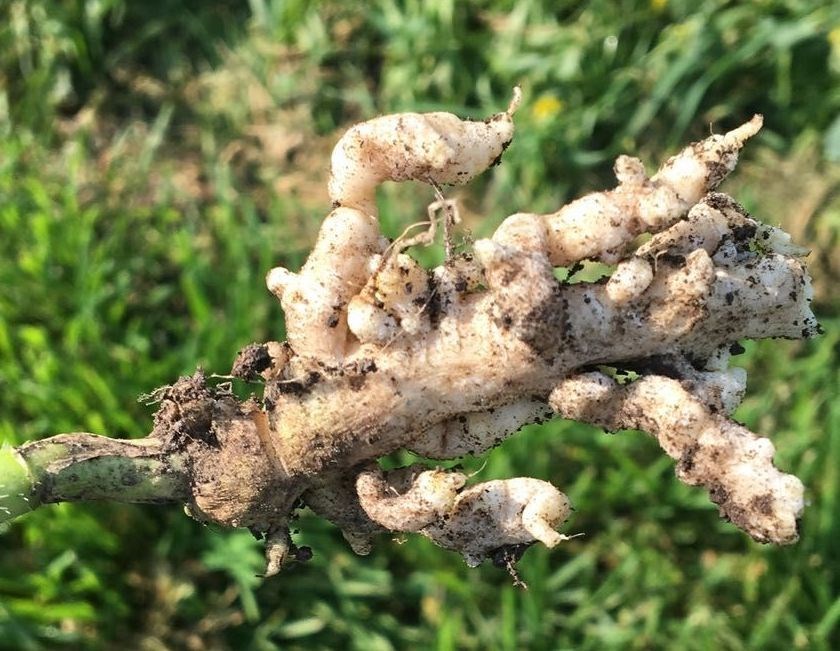Manitoba R.M. Hillsburg-Roblin-Shell River is in the red. Swan Valley West is also in the red. The “red” in this case designates high risk zones for clubroot in Manitoba. These municipalities have fields showing clubroot symptoms and fields with well over 80,000 clubroot spores per gram of soil. Canola grown in these areas will be at high risk for clubroot.
“In Manitoba, we may not be taking clubroot as seriously as we should,” says John Sandborn, who farms at Benito and is a director with the Manitoba Canola Growers Association. “But it’s here and spore levels are rising. Given the value of canola for farmers in this part of the province, we need to start looking for it in our fields and taking preventative action to keep it from reducing our canola profitability.”
Scouting can start now. Galls can begin to form on canola plants about three weeks after germination and will grow steadily until harvest. Any time you’re in a field, pull up plants to check for galls – which are white, round tuber-like structures growing along the roots, often close to the taproot. They will grow throughout the season and could be the size of grapes, or larger, by harvest time. Even if these galls don’t reduce yields this year, they can cause a massive increase in spore loads in those fields. As part of their in-season scouting, farmers and agronomists can test soil for clubroot DNA. The PSI Lab in Winnipeg has instructions on how to take a soil test for clubroot. Manitoba Canola Growers Association offers a free clubroot soil test for their farmer members.
Be diligent in scouting for clubroot. Pull up plants at field entrances, low spots, water runs, weedy areas, lease roads and any areas with a history of higher soil disturbance or traffic.
The goal with long-term clubroot management is to keep spore levels low. That is why early detection is so valuable. While scouting is one thing farmers and agronomist can do now, it is just one step in the recipe for effective clubroot management*
The clubroot management recipe
1. Vigilantly scout all canola fields for symptoms, even if growing a clubroot-resistant (CR) variety.
2. Keep a minimum two-year break between canola crops. This crop rotation is crucial in the stewardship of genetic resistance. With a two-year break between clubroot hosts, fields can experience a rapid decline in living resting spores.
3. Seed CR varieties and understand if/when to deploy different sources of resistance. Planting CR varieties before the disease arrives and gets established will give you a better chance of keeping the resting spore load at a manageable level, maintaining effective resistance. Rotation of resistance could also be important to maintain resistance efficacy. With repeated use of varieties with the same resistance traits under high spore loads, virulent races can multiply, making even a resistant variety highly susceptible to infection.
4. Limit activities that can introduce foreign soil or cause erosion. Minimum tillage and equipment sanitation (as simple as knocking off visible dirt before leaving a field) will greatly reduce the risk of moving infested soil around. Note that wet soil conditions increase the amount of soil that clings to equipment.
5. Control host weeds. Common weeds that can host clubroot include stinkweed, shepherd’s purse, flixweed, all mustards and volunteer canola. They need to be controlled within three weeks of emergence to prevent a new batch of spores being produced.
6. Isolate field entrances and hot spots. Use patch management strategies to reduce spore loads, such as grassing the affected area, which will also limit soil movement. Patches that are visibly worse than the remainder of your field often have billions more spores per gram of soil than elsewhere and are often the first place where clubroot resistance breaks down. Removing these hot spots from cultivation for a few extra years significantly reduces spread and risk of resistance breakdown. As part of this, having separate field entrances and exits could reduce the amount of infested soil leaving the field on machinery.
To find the latest Manitoba map, go to gov.mb.ca/agricultureand search for “clubroot map”. For details on clubroot prevention and management, including information on soil testing and contact information for the PSI Lab, go to clubroot.ca.
– Justine Cornelsen is the Canola Council of Canada agronomy specialist for Western Manitoba.




